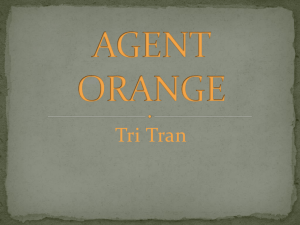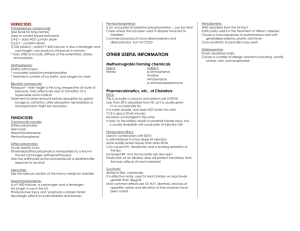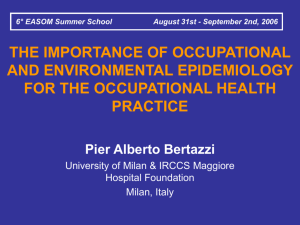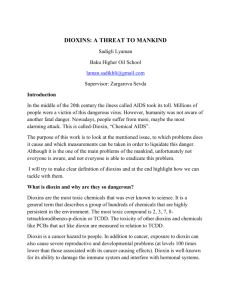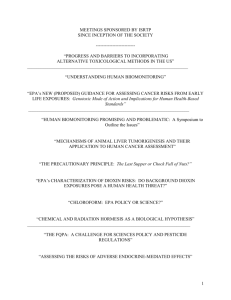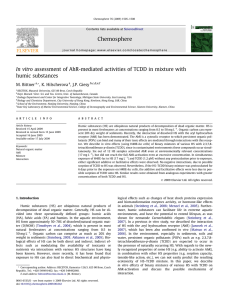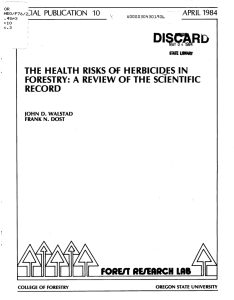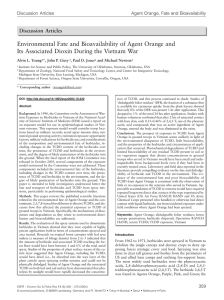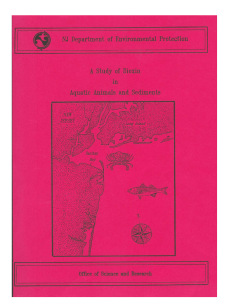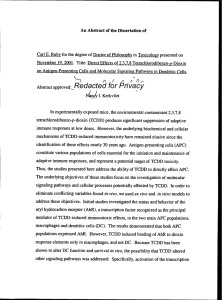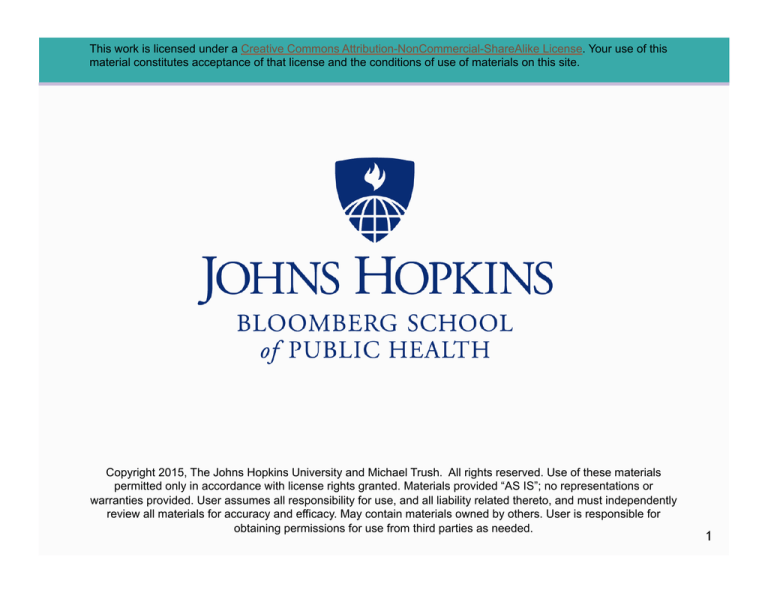
This work is licensed under a Creative Commons Attribution-NonCommercial-ShareAlike License. Your use of this
material constitutes acceptance of that license and the conditions of use of materials on this site.
Copyright 2015, The Johns Hopkins University and Michael Trush. All rights reserved. Use of these materials
permitted only in accordance with license rights granted. Materials provided “AS IS”; no representations or
warranties provided. User assumes all responsibility for use, and all liability related thereto, and must independently
review all materials for accuracy and efficacy. May contain materials owned by others. User is responsible for
obtaining permissions for use from third parties as needed.
1
Section D
Human Aspects of Dioxin Exposure
The material in this video is subject to the copyright of the owners of the material and is being provided for educational purposes under
rules of fair use for registered students in this course only. No additional copies of the copyrighted work may be made or distributed.
Incidents Resulting in Significant Dioxin Exposure
3
Workers Exposed to Dioxin in Industrial Accidents
Year
Location
Company
1966 Grenoble, France Rhone-Poulenc
1968 Derbyshire, UK
1976 Seveso, Italy
Coalite
ICMESA
Exposed
Remarks
?
21 chloracne cases
90
79 chloracne cases
156
134 confirmed chloracne
cases; overall mortality
rate normal
4
1976 Seveso, Italy, Accident
! The affected area was split into zones
- A, B, and R in decreasing order of surface soil concentrations of
TCDD; Zone A was further split into 7 sub-zones
! The local population was advised not to touch or eat locally grown
fruits or vegetables
! Zone A had a TCDD soil concentration of > 50 micrograms per square
meter (µg/m²); it had 736 residents
! Zone B had a TCDD soil concentration of between 5 and 50 µg/m²;
it had about 4,700 residents
! Zone R had negligible or a TCDD soil concentration of < 5 µg/m²;
it had 31,800 residents
5
1976 Seveso, Italy, Accident
! Within days, a total of 3,300 animals were found dead, mostly
poultry and rabbits
- Emergency slaughtering commenced to prevent TCDD from
entering the food chain
- By 1978, over 80,000 animals had been slaughtered
! 15 children were quickly hospitalized with skin inflammation
! Within months, Zone A had been completely evacuated and fenced
- 1,600 people of all ages had been examined
- 447 were found to suffer from skin lesions or chloracne
! An advice center was set up for pregnant women
- Several opted for an abortion, which was legal in special cases,
after consultation
6
Effects of Dioxin Exposure
This image can not be provided
due to copyright
7
Estimated Peak TCDD Levels in Humans
Estimated Peak TCDD Levels (ppt Lipid) in Humans
(Back-Calculated from Current Serum Levels)
Cohort
Background
Seveso Zone A
N
Mean
Pooled
5.2
7
230
Seveso Zone A, medical
296
Seveso Zone B
51
Seveso Zone B, medical
80
Dutch accident
14
Range
41–400
1.5–56,000
47.5
5.3–273
1–545
1,842
300–3,683
8
1976 Seveso, Italy, Accident
! A 1991 study, 14 years after the accident, sought to assess the
effects to the thousands of persons that had been exposed to dioxin
! The most evident adverse health effect ascertained was chloracne
(193 cases)
! Other reversible early effects noted were peripheral neuropathy and
liver enzyme induction
! The ascertainment of other, possibly severe sequelae of dioxin
exposure (e.g., birth defects) was hampered by inadequate
information; however, generally, no increased risks were evident
9
1976 Seveso, Italy, Accident
! An excess mortality from cardiovascular and respiratory diseases
was uncovered
- Possibly related to the psychosocial consequences of the
accident in addition to the chemical contamination
! An excess of diabetes cases was also found
! Results of cancer incidence and mortality follow-up showed an
increased occurrence of cancer of the gastrointestinal sites and of
the lymphatic and hematopoietic tissue
! In 2009, an update including five more years (up to 1996) found an
increase in “lymphatic and hematopoietic tissue neoplasms” and
increased breast cancer
10
Herbicide Use in Vietnam
! Herbicides were used around the perimeters of fire bases to keep
the concertina wire clear of vegetation, providing an open view for
sentries on guard duty
! Herbicides were also sprayed along river banks to reduce the
number of US casualties in the Brown Water Navy
! The largest volume of herbicide was applied from the air by C-123
"Provider" twin-engine aircraft
- This air spray program was code named Operation Ranch Hand
11
Herbicides Used in Vietnam
Agent
Agent Orange
Composition
2,4-D and 2,4,5-T
Agent Orange II “Super Orange” 2,4-D and 2,4,5-T
Years
1/65–4/70
1968 and 1969
Agent Purple
2,4-D and 2,4,5-T
1/62–1964
Agent Pink
2,4,5-T
1962–1964
Agent Green
2,4,5-T
1962–1964
Agent White
Picloram and 2,4-D
—
Agent Blue
Cacodylic acid (arsenic)
—
Dinoxol
2,4-D and 2,4,5-T
1962–1964
Trinoxol
2,4,5-T
1962–1964
Diquat
Diquat
1962–1964
12
Herbicide Use in Vietnam
Key to Map
Figures indicate the number
of gallons of herbicide
applied during the Vietnam
war.
This image can not be
provided due to
copyright
(O): Agent Orange
(B): Agent Blue
(W): Agent White
Dates indicate the last time
herbicides were used in that
province.
13
Operation Ranch Hand
This image can not be provided
due to copyright
14
Estimated Peak TCDD Levels in Humans
Estimated Peak TCDD Levels (ppt Lipid) in Humans
(Back-Calculated from Current Serum Levels)
Cohort
Background
Ranch hand, low
Ranch hand, high
Hamburg woman
NIOSH
BASF (severe chloracne)
BASF (moderate chloracne)
BASF (no chloracne)
N
Pooled
276
283
65
253
56
59
139
Mean
5.2
52
196
507
2,000
1,008
421
38
Range
27–94
94–3,290
2.4–6,397
2–32,000
20–13,360
2.7–4,915
2.7–2,981
15
Ranch Hands
! A committee examined more than 230 epidemiological studies in
detail on a range of health problems and their possible association
with herbicides
! It found sufficient evidence of a statistical association between
exposure to herbicides or dioxin and:
- Soft tissue sarcoma
- Non-Hodgkin's lymphoma
- Hodgkin's disease
! The committee also found sufficient evidence of an association
between herbicides or dioxin and chloracne and porphyria cutanea
tarda (PCT) in genetically susceptible individuals
- PCT is a liver disorder characterized by thinning and blistering
of the skin
16
Friendship Village
! Vietnam Friendship Village is a residential treatment center for
children and veterans affected by Agent Orange
- Located on 27,000 square meters of former rice paddy in Van
Canh commune, Hoai Duc hamlet, Ha Tay Province, about 16 km
from downtown Hanoi
- There are approximately 120 children, 30 war veterans, and 43
staff members living and working there at any one time
17
O’Neill (2000)—Damaged Lives, Pittsburgh Post-Gazette
This image can not be provided due to copyright
18
Effects of Dioxin Exposure
This image can not be provided due to copyright
19
Dioxin in the News
This image can not be provided due to copyright
20
Viktor Yushchenko
This image can not be provided due to copyright
21
Toxic Effects of Dioxins Seen in Humans
Following adult exposure:
Poryphria
+
Chloracne
+
Hepatotoxicity
+
Neurotoxicity
+
Altered glucose metabolism
+/–
Carcinogenicity
+/–
Endocrine effects (FSH/LH)
+/–
Cardiovascular effects
+/–
22
Summary
! POPs defined
! Structures
! Risks
! Toxicology
23
Lecture Evaluation
Please take a moment to evaluate
this lecture. Your feedback is very
important and will be used for future
revisions. The Evaluation link is
available on the lecture page.
24

